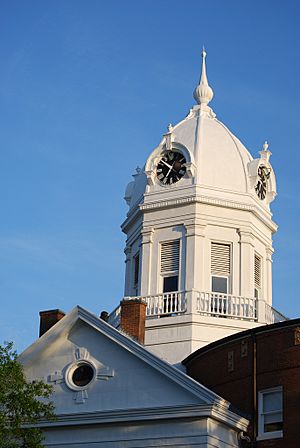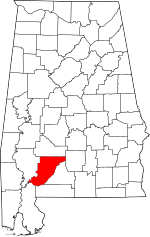Monroe County, Alabama facts for kids
Quick facts for kids
Monroe County
|
|
|---|---|

The Old Monroe County Courthouse in Monroeville
|
|

Location within the U.S. state of Alabama
|
|
 Alabama's location within the U.S. |
|
| Country | |
| State | |
| Founded | June 29, 1815 |
| Named for | James Monroe |
| Seat | Monroeville |
| Largest city | Monroeville |
| Area | |
| • Total | 1,034 sq mi (2,680 km2) |
| • Land | 1,026 sq mi (2,660 km2) |
| • Water | 8.7 sq mi (23 km2) 0.8% |
| Population
(2020)
|
|
| • Total | 19,772 |
| • Estimate
(2021)
|
19,648 |
| • Density | 19.122/sq mi (7.383/km2) |
| Time zone | UTC−6 (Central) |
| • Summer (DST) | UTC−5 (CDT) |
| Congressional district | 1st |
|
|
Monroe County is a county located in the southwestern part of the U.S. state of Alabama. As of the 2020 census, the population was 19,772. Its county seat is Monroeville. Its name is in honor of James Monroe, fifth President of the United States. It is a dry county, in which the sale of alcoholic beverages is restricted or prohibited, but Frisco City and Monroeville are wet cities.
In 1997, the Alabama Legislature designated Monroeville and Monroe County as the "Literary Capital of Alabama". It is the birthplace of notable writer Harper Lee and served as the childhood home for Truman Capote, her lifelong friend and a fellow writer. Lee lived here most of her life. The enduring popularity of her novel, To Kill a Mockingbird (1960), as well as its film and stage adaptations, has attracted tourists to the city and area. Monroeville is also central to the 2019 film Just Mercy, based upon the 2014 eponymous book by Bryan Stevenson, recounting the wrongful conviction and sentencing to death of African American Walter McMillian.
Contents
History
For thousands of years the area was inhabited by indigenous peoples. In historic times, it was primarily the territory of the Creek peoples, who became known to European-American settlers as one of the Five Civilized Tribes of the Southeast.
The prominent Upper Creek chief Red Eagle (also known as William Weatherford), of the prominent Wind Clan, settled here after the Creek War (1813-1814). At the time, the United States was also involved in the War of 1812 against Great Britain. Red Eagle established a successful plantation. He was of Creek and European descent, and had adopted chattel slavery to gain workers for his plantation and horse breeding. Most of the Creek people were removed from Alabama to Indian Territory (now Oklahoma) in the 1830s.
The area was settled by European Americans, primarily of English and Scots-Irish descent. It was largely developed as cotton plantations in the antebellum years. Planters moving from the Upper South sometimes brought slave workers with them, or purchased more from traders and markets after acquiring land. The population was made up of numerous slaves, who at times outnumbered the whites.
Following the American Civil War and Emancipation, in the period after the Reconstruction era and into the early 20th century, white Democrats regained control of the state legislature and worked to restore and maintain white supremacy. The legislature passed a new constitution in the early 1900s that disfranchised most blacks and many poor whites, excluding them from the political system. The legislators also passed laws imposing racial segregation and other forms of Jim Crow. Attacks against blacks were varied. Physical terrorism was accomplished through lynchings, mostly of black men, and often attended by crowds of whites in a public display of their power.
The county seat, Monroeville, is the home of two notable 20th-century authors, Truman Capote and Nelle Harper Lee, who were childhood neighbors. The novelist Mark Childress and journalist Cynthia Tucker are also Monroe County natives. In 1997 the Alabama legislature designated Monroeville and Monroe County as the "Literary Capital of Alabama."
The county is near the Gulf Coast and is affected by storms from the gulf. It has twice been declared a disaster area due to extensive hurricane damage: in September 1979 due to Hurricane Frederic, and in September 2004 due to Hurricane Ivan.
Attorney Bryan Stevenson published his memoir, Just Mercy: A Story of Justice and Redemption in 2014. He has worked since his early 20s in Mobile, establishing the Equal Justice Initiative and serving as legal counsel for people on death row in Alabama prisons. He has succeeded in gaining freedom for some men who were wrongfully convicted. Among the cases he discusses is that of Walter McMillan on Monroeville, who was wrongfully convicted of murder in 1989. McMillan, an African American from Monroe County, was sentenced to death by the trial judge who overrode the jury. He was kept on death row for 6 years, nearly 2 of which were prior to being convicted, in an effort to make him confess. The Alabama Appeals Court ruled in 1993 that he should be freed because of the lack of evidence, his alibi, the unreliability of witnesses, and mishandling of the trial.
Geography
According to the U.S. Census Bureau, the county has a total area of 1,034 square miles (2,680 km2), of which 1,026 square miles (2,660 km2) is land and 8.7 square miles (23 km2) (0.8%) is water.
Major highways
 U.S. Highway 84
U.S. Highway 84 State Route 21
State Route 21 State Route 41
State Route 41 State Route 47
State Route 47 State Route 59
State Route 59 State Route 83
State Route 83 State Route 136
State Route 136
Adjacent counties
- Wilcox County (north)
- Butler County (east-northeast)
- Conecuh County (east)
- Escambia County (southeast)
- Baldwin County (southwest)
- Clarke County (west)
Demographics
| Historical population | |||
|---|---|---|---|
| Census | Pop. | %± | |
| 1820 | 8,838 | — | |
| 1830 | 8,782 | −0.6% | |
| 1840 | 10,680 | 21.6% | |
| 1850 | 12,013 | 12.5% | |
| 1860 | 15,667 | 30.4% | |
| 1870 | 14,214 | −9.3% | |
| 1880 | 17,091 | 20.2% | |
| 1890 | 18,990 | 11.1% | |
| 1900 | 23,666 | 24.6% | |
| 1910 | 27,155 | 14.7% | |
| 1920 | 28,884 | 6.4% | |
| 1930 | 30,070 | 4.1% | |
| 1940 | 29,465 | −2.0% | |
| 1950 | 25,732 | −12.7% | |
| 1960 | 22,372 | −13.1% | |
| 1970 | 20,883 | −6.7% | |
| 1980 | 22,651 | 8.5% | |
| 1990 | 23,968 | 5.8% | |
| 2000 | 24,324 | 1.5% | |
| 2010 | 23,068 | −5.2% | |
| 2020 | 19,772 | −14.3% | |
| 2021 (est.) | 19,648 | −14.8% | |
| U.S. Decennial Census 1790–1960 1900–1990 1990–2000 2010–2020 |
|||
2020
| Race | Num. | Perc. |
|---|---|---|
| White | 10,334 | 52.27% |
| Black or African American | 8,253 | 41.74% |
| Native American | 281 | 1.42% |
| Asian | 88 | 0.45% |
| Other/Mixed | 609 | 3.08% |
| Hispanic or Latino | 207 | 1.05% |
As of the 2020 United States census, there were 19,772 people, 8,166 households, and 5,124 families residing in the county.
2010
According to the 2010 United States census:
- 55.1% White
- 41.7% Black
- 1.1% Native American
- 0.3% Asian
- 0.0% Native Hawaiian or Pacific Islander
- 1.4% Two or more ethnicities
- 1.0% Hispanic or Latino (of any ethnicity)
2000
As of the census of 2000, there were 24,324 people, 9,383 households and 6,774 families residing in the county. The population density was 24 people per square mile (9/km2). There were 11,343 housing units at an average density of 11 per square mile (4/km2). The ethnic makeup of the county was 57.75% White, 40.07% Black or African American, 0.97% Native American, 0.29% Asian, 0.01% Pacific Islander, 0.13% from other races, and 0.79% from two or more ethnicities while 0.78% of the population were Hispanic or Latino of any ethnicity.
There were 9,383 households, out of which 35.60% had children under the age of 18 living with them, 52.30% married couples living together, 16.10% with a female householder and no husband present and 27.80% non-families. Slightly more than a quarter (25.70%) of all households were made up of individuals, and 11.10% had someone living alone who was 65 years of age or older. The average household size was 2.57 and the average family size was 3.09.
In the county, the population was spread out, with 28.30% under the age of 18, 8.60% from 18 to 24, 26.80% from 25 to 44, 22.50% from 45 to 64, and 13.80% who were 65 years of age or older. The median age was 35 years old. For every 100 females, there were 90.80 males. For every 100 females, aged 18 and over, there were 86.40 males.
The median income for a household in the county was $29,093, and the median income for a family was $34,569. Males had a median income of $31,096 versus $18,767 for females. The per capita income for the county was $14,862. About 18.20% of families and 21.30% of the population were below the poverty line, including 27.00% of those under age 18 and 21.40% of those aged 65 or over.
Communities
City
- Monroeville (county seat)
Towns
Census-designated places
Unincorporated communities
Ghost town
Places of interest
Monroe County is home to several attractions, such as the Alabama River Museum, the Monroe County Heritage Museum, and the Courthouse Museum which hosts the annual stage production of To Kill a Mockingbird. The county also contains Claude Kelly State Park.
Images for kids
See also
 In Spanish: Condado de Monroe (Alabama) para niños
In Spanish: Condado de Monroe (Alabama) para niños


